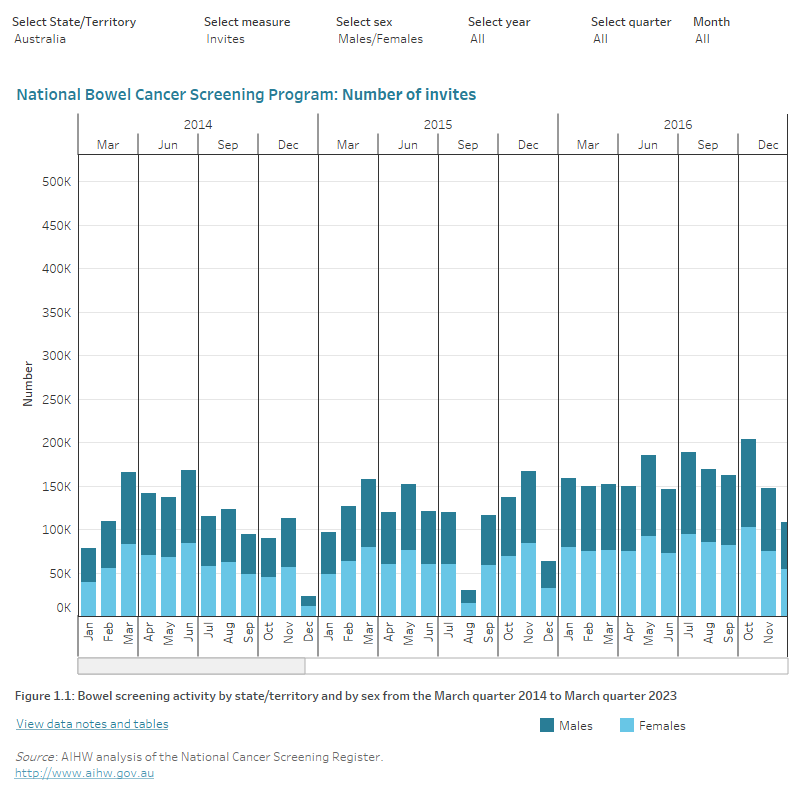Bowel cancer screening activity
On this page:
For the National Bowel cancer Screening Program (NBCSP), activity data are available on:
- the number of invitations sent out during a given period and
- the number of completed screening test kits returned for analysis.
Explore the latest data in the visualisation below.
Bowel screening invitations sent
In the March quarter 2023:
- 846,000 invitations to participate in the screening program were sent to eligible people aged 50–74.
- Of these invitations, 52% were sent to women (437,000) and 48% sent to men (409,000).
Bowel screening kits returned
In the March quarter 2023:
- 363,000 completed screening kits were returned for analysis.
- Of these kits, 54% were returned by women (197,000) and 46% returned by men (166,000).
- The number of completed kits returned was higher than in the December quarter 2023 (296,000) and the March quarter a year prior (193,000).
Trends in bowel cancer screening activity
Between the March quarter 2014 and the March quarter 2023:
- The number of invitations fluctuated across time, from a low of 225,000 in the December quarter 2014 to a peak of 1.3 million invitations in the June quarter 2020.
- Invitations were lowest in March and December quarters and usually peaked in June quarters before beginning to fall in September quarters:
-
In 2022, this pattern continued with 496,000 in the March quarter, climbing to 876,000 in the June quarter, falling to 862,000 in the September quarter, and then to 666,000 in the December quarter.
-
The March quarter 2023 experienced a peak in the number of invitations sent and the number of completed kits returned (846,000 invitations and 363,000 kits respectively) compared to the March quarters of the 3 previous years (496,000 invitations and 193,000 kits in 2022, 693,000 invitations and 243,000 kits in 2021 and 752,000 invitations and 166,000 kits in 2020).
-
- Observable drops in the number of invitations during summer months is potentially due to the NBCSP Hot-Zone policy. Through the Hot Zone Policy, the program avoids sending invitations to locations where average monthly temperatures are greater than 30° degrees Celsius. Blood present in a collected sample may break down and be more difficult to detect when exposed to high temperatures. To avoid this potential risk, invitations are instead scheduled for sending during cooler times of the year (DHAC 2017).
- The increased number of NBCSP invitations sent and kits returned reflects the staged roll-out of the NBCSP. Additional age groups were progressively invited to screen. The program was fully rolled out (with all age groups included) in 2020. See the National Bowel Cancer Screening Program age groups invited by year section of the Technical notes for more information.
For more information about the impact of COVID-19 on Australia’s cancer screening programs, see the AIHW Cancer screening page and the AIHW report Cancer screening and COVID-19 in Australia.
Figure 1: National Bowel Cancer Screening Program activity data by sex, March quarter 2014 to March quarter 2023
This data visualisation shows monthly national activity data for the National Bowel Cancer Screening Program from January 2014 to March 2023. The column graph shows the number of screening tests by year and can be filtered by measure (invitations made and kits returned), year, quarter, month, sex (males/females and persons) and state and territory. The second tab shows the activity data in table form, and can be filtered by measure, by year, by quarter and by month.

References
AIHW (Australian Institute of Health and Welfare) (2021) Cancer screening and COVID-19 in Australia, catalogue number CAN 137, AIHW, Australian Government, accessed 6 December 2022.
AIHW (2022) Cancer screening, AIHW, Australian Government, accessed 6 December 2022.
DHAC (Department of Health and Aged Care) (2017) National Bowel Cancer Screening Program policy framework, Health, Australian Government, accessed 6 December 2022.


